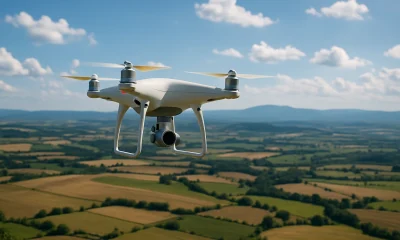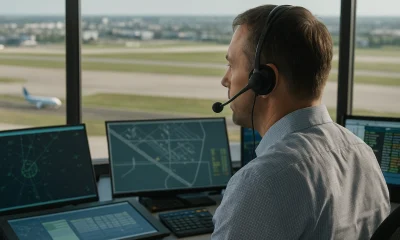- Acronym Guide
- AAM
- ABS
- AC
- ACAS
- ADS-B
- AEHF
- AFAC
- AGL
- AI
- AIM
- ALPA
- ALS
- AM
- AMA
- ANSP
- AOI
- APPI
- AUV
- AUVSI
- ARPAS-UK
- ASTM
- ATC
- ATO
- BLOS
- BVLOS
- CAA
- CAAC
- CAB
- CAP
- CASA
- CATT
- CBO
- CBR
- CBRN
- CDMA
- CDR
- CFI
- CFR
- CIR
- COA
- COMINT
- CORS
- COTP
- COTR
- CPTED
- CV
- C2
- DAA
- DAS
- DEM
- DFI
- DFS
- DGCA
- DHS
- DOD
- DPA
- DPEs
- DRG
- DRO
- DSM
- DSMX
- DSP
- DSSS
- DTM
- EASA
- EFT
- EO
- EOD
- EO/IR
- ELINT
- EMI
- ESC
- EVLOS
- eVTOLs
- FAA
- FCC
- FCS
- FHSS
- FICCI
- FLIR
- FOB
- FOV
- FPS
- FPV
- GBDAA
- GCP
- GCS
- GDPR
- GML
- GNSS
- GPS
- GSD
- GVC
- HDR
- HOGE
- IACRA
- ICAO
- ICS
- IED
- IMU
- INS
- IR
- ISA
- ISR
- ITU
- JARUS
- LAAMS
- LAANC
- LAATM
- LAI
- LAS
- LBA
- LIDAR
- LOS
- LSALT
- MAC
- MAVLink
- MLIT
- MMS
- MSL
- MTOM
- NDAA
- NCSL
- NFZ
- NIST
- NMEA
- NOTAM
- NPA
- NPRM
- NTIA
- OBIA
- OEM
- OFDM
- OGI
- OOP
- PAS
- PASM
- PAV
- PCV
- PdM
- PEC
- PIC
- PID
- PIPL
- PLD
- PM
- PN
- PPK
- PPS
- PSM
- PTZ
- PWM
- UAM
- UAOP
- UAS
- UASTM
- UAV
- UCAVs
- UHD
- UHF
- USV
- UTM
- RAIM
- RCC
- RCS
- RED
- ReOC
- RePL
- RFI
- RMS
- ROI
- RPAS
- RPC
- RTH
- RTN
- RTK
- SaR
- SAR
- SARP
- SBAS
- S.Bus
- SBIR
- SEDENA
- SfM
- SFOC
- SIGINT
- SLAM
- SMS
- SOP
- SORA
- STANAG
- STTR
- STK
- sUAS
- TCAS
- TCCA
- TFR
- TIN
- TLM
- TOF
- TP
- TPS
- TSA
- VHF
- VLOS
- VTOL
Drone Acronyms
What is ADS-B (Automatic Dependent Surveillance-Broadcast)?
By
Jacob StonerTable Of Contents

Definition
ADS-B stands for Automatic Dependent Surveillance-Broadcast. It is a surveillance technology in which an aircraft determines its position via satellite navigation and periodically broadcasts this information, enabling it to be tracked by air traffic control and other aircraft.
Relevance to the Industry
ADS-B is crucial for integrating drones into controlled airspace. It allows for safer and more efficient airspace management by providing precise location data. This technology is particularly important for commercial drone operations, long-distance flights, and operations in busy or controlled airspaces.
How Does Automatic Dependent Surveillance-Broadcast (ADS-B) Work?
Automatic Dependent Surveillance-Broadcast (ADS-B) is a surveillance technology that allows aircraft to broadcast their position and other relevant information to air traffic control (ATC) and other nearby aircraft. This system enhances situational awareness and safety in aviation. Here’s a detailed explanation of how ADS-B works:
1. System Components
- GPS Receiver: Provides precise position, velocity, and time information to the aircraft’s avionics system.
- ADS-B Out Transmitter: Transmits the aircraft’s position, velocity, and other relevant information to ground stations and other aircraft.
- ADS-B In Receiver: Receives ADS-B signals from other aircraft and ground stations, providing situational awareness to the pilot.
- Antenna System: Facilitates the transmission and reception of ADS-B signals.
2. Data Generation and Broadcast
- Position Determination: The aircraft’s GPS receiver continuously determines its precise position using signals from GPS satellites.
- Data Encoding: The position data, along with other information such as velocity, altitude, aircraft identification, and intent, is encoded into a digital signal by the ADS-B Out transmitter.
- Broadcasting: The encoded data is broadcast periodically (typically once per second) via a dedicated radio frequency (usually 1090 MHz or 978 MHz, depending on the region).
3. Data Reception and Processing
- Ground Stations: ADS-B ground stations receive the broadcasted signals from aircraft. These ground stations are part of the air traffic control infrastructure.
- Other Aircraft: Aircraft equipped with ADS-B In receivers can also receive the broadcasted signals from nearby aircraft, providing pilots with real-time information about surrounding traffic.
- Data Decoding: The received signals are decoded by the ground stations or onboard systems to extract the position, velocity, and other relevant information.
4. Information Utilization
- Air Traffic Control: The decoded data from ground stations is sent to air traffic control centers, where it is used to monitor and manage air traffic. Controllers can see the precise positions and movements of aircraft on their radar screens, improving traffic management and safety.
- Cockpit Displays: Pilots receive real-time information about nearby traffic and potential conflicts through cockpit displays, enhancing situational awareness and collision avoidance.
- Traffic Information Services: ADS-B data can be integrated with other traffic information services (TIS) to provide a comprehensive picture of air traffic in the area.
5. Operational Benefits
- Enhanced Safety: ADS-B provides more accurate and timely information about aircraft positions, reducing the risk of mid-air collisions and improving overall airspace safety.
- Improved Efficiency: ADS-B enables more efficient routing and spacing of aircraft, leading to reduced fuel consumption, lower emissions, and increased airspace capacity.
- Cost-Effectiveness: Compared to traditional radar systems, ADS-B is less expensive to install and maintain, making it a cost-effective solution for air traffic surveillance.
- Global Coverage: ADS-B can provide surveillance coverage in remote and oceanic areas where traditional radar systems are not feasible.
6. Applications and Use Cases
- Commercial Aviation: Airlines use it for real-time tracking of their fleets, improving operational efficiency and safety.
- General Aviation: Private pilots benefit from enhanced situational awareness and traffic information, particularly in congested airspace.
- Military Aviation: It supports military operations by providing accurate tracking and coordination of aircraft movements.
- Unmanned Aircraft Systems (UAS): It is being integrated into drone operations to ensure safe integration into controlled airspace.
- Search and Rescue: It can assist in search and rescue operations by providing accurate last known positions of aircraft in distress.
Understanding how ADS-B works highlights its critical role in modernizing air traffic surveillance and management. By providing precise and real-time information about aircraft positions and movements, ADS-B significantly enhances the safety, efficiency, and capacity of global airspace.
Example in Use
“Equipped with ADS-B, the drone provided real-time location data, ensuring safe integration into the crowded airspace.”
How ADS-B Integrates with Commercial Flight:
Enhanced Traffic Management:
- Allows for precise tracking of all aircraft, improving overall airspace management. Drones equipped with this technology can be monitored alongside commercial aircraft, ensuring that all operators are aware of each other’s positions.
Increased Situational Awareness:
- Real-time position data from equipped drones helps commercial pilots and air traffic controllers maintain situational awareness. This reduces the risk of collisions and enhances the safety of both manned and unmanned aircraft operations.
Seamless Airspace Integration:
- Drones can operate in controlled airspace alongside commercial flights. This technology facilitates the safe integration of drones by providing a common platform for position reporting and collision avoidance.
Regulatory Compliance:
- In many regions, regulatory bodies mandate the use of ADS-B for certain types of drone operations, especially in controlled or congested airspaces. Compliance with these regulations is crucial for the legal operation of drones in commercial airspace.
Frequently Asked Questions about ADS-B (Automatic Dependent Surveillance-Broadcast)
1. What is ADS-B and how does it work?
Answer: ADS-B (Automatic Dependent Surveillance-Broadcast) is a technology that allows aircraft, including drones, to determine their position using satellite navigation. This position information, along with other data like velocity and altitude, is periodically broadcast to enable tracking by air traffic control and other nearby aircraft. It enhances situational awareness and improves safety by providing real-time information about an aircraft’s location and movements.
2. Why is ADS-B important for drones?
Answer: ADS-B is important for drones because it:
- Enhances Airspace Safety: Provides real-time position data, reducing the risk of mid-air collisions.
- Facilitates Airspace Integration: Allows drones to be tracked by air traffic control, enabling safer integration into controlled airspaces.
- Improves Situational Awareness: Helps other equipped aircraft and operators to see and avoid drones.
- Supports Regulatory Compliance: Meets requirements for operating in certain airspaces, ensuring legal and safe drone operations.
3. What are the benefits of using ADS-B in drone operations?
Answer: The benefits of using ADS-B in drone operations include:
- Increased Safety: Enhances collision avoidance and situational awareness for both drone operators and other airspace users.
- Better Airspace Management: Enables efficient tracking and management of drone traffic, particularly in busy or controlled airspaces.
- Compliance with Regulations: Helps drone operators comply with aviation regulations, especially in regions where it is mandated.
- Enhanced Operational Capabilities: Supports complex and long-range missions by providing reliable position data and improving coordination with manned aircraft.
For examples of these acronyms visit our Industries page.
As the CEO of Flyeye.io, Jacob Stoner spearheads the company's operations with his extensive expertise in the drone industry. He is a licensed commercial drone operator in Canada, where he frequently conducts drone inspections. Jacob is a highly respected figure within his local drone community, where he indulges his passion for videography during his leisure time. Above all, Jacob's keen interest lies in the potential societal impact of drone technology advancements.
Pros
Cons
You may like


What is RED (Rapid Extraction Device) & How Does it Work?


What is IED (Improvised Explosive Device) & How Does it Work?


What is BLOS (Beyond Line of Sight) & How Does it Work?


What is ATO (Authority to Operate) & How Does it Work?


What is ALPA (Air Line Pilots Association) & How Does it Work?


What is AEHF (Advanced Extremely High Frequency)?